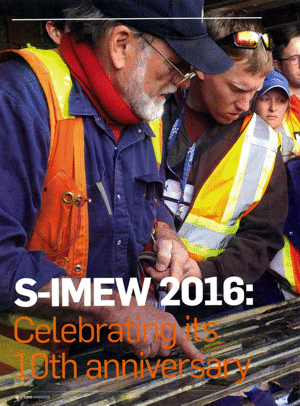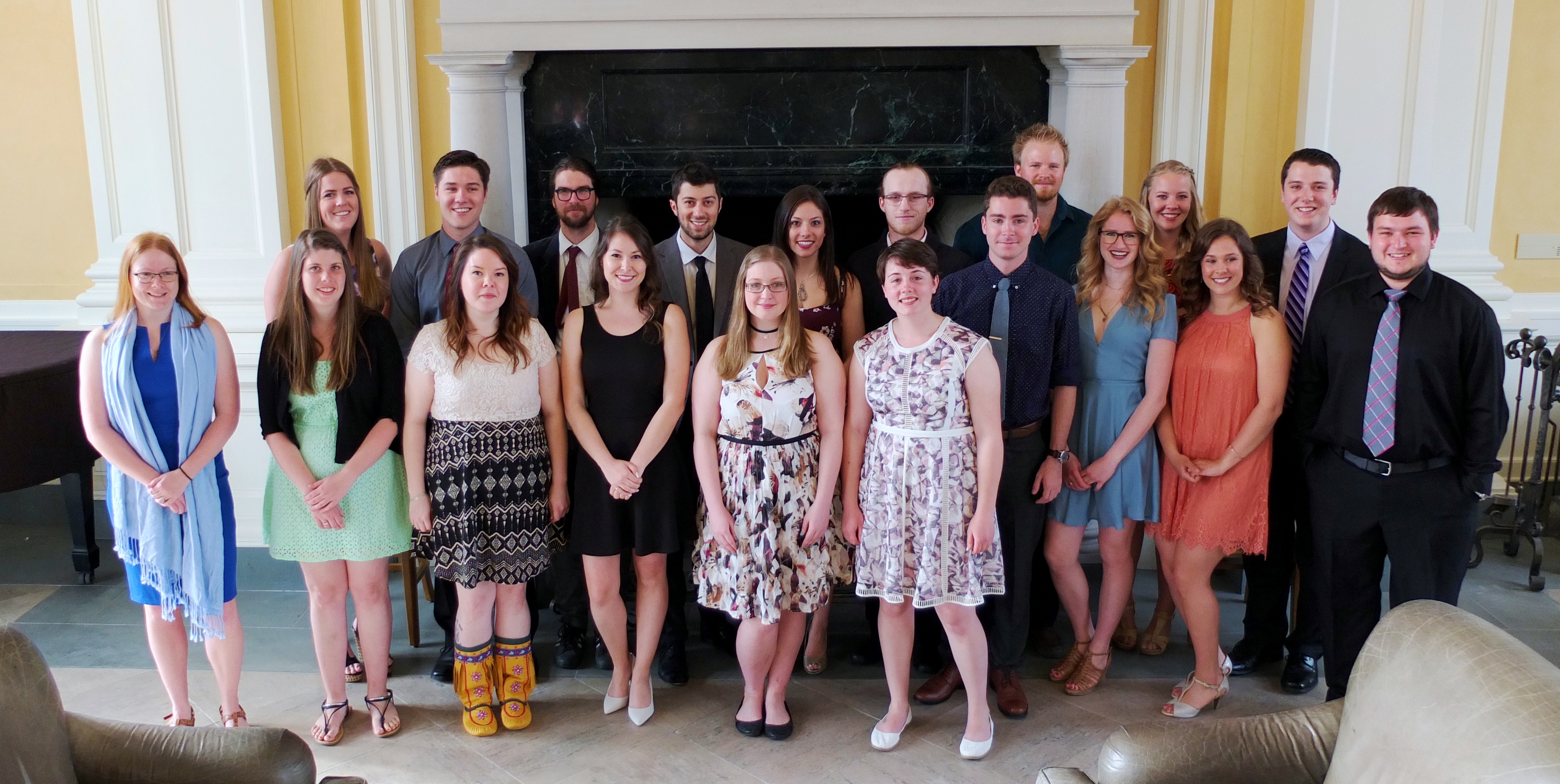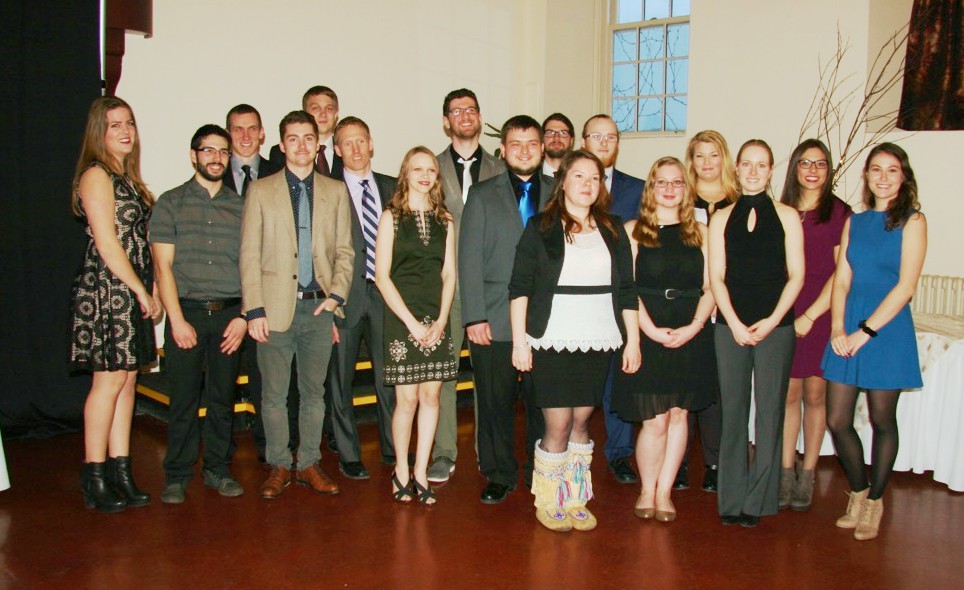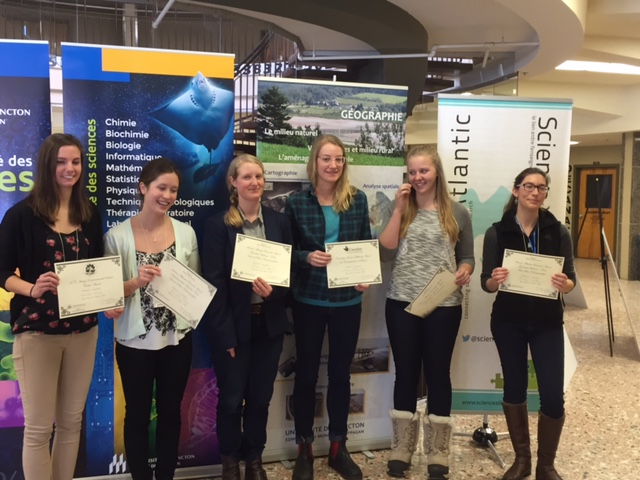Archive of news items - 2016
Matthew Baker: from environmental science to policy analyst
A degree in environmental science may not seem an obvious route to a position as a policy analyst for the Nova Scotia government.
For Matthew Baker (BSc ’12), however, the knowledge and skills he developed at Acadia University were a good match for the Sustainable and Renewable Energy Division of the Nova Scotia Department of Energy. While nearing completion of his masters of science last winter, he was hired under the provincial government’s Make It Here youth hiring initiative.

“We’re very happy with how Matthew’s been able to apply his knowledge,” says Sandra Farwell, director of the Sustainable and Renewable Energy Division. “He’s integrating his academic knowledge with technical skills and putting it into practical use for the government. His experience with Acadia has been very helpful for the work we do on tidal energy. He has a strong work ethic, and he’s very professional.”
Applying classroom skills to a career
Still an active MSc candidate, Matthew took the job with the encouragement of his thesis supervisor, Dr. Anna Redden, who is the director of the Acadia Centre for Estuarine Research and of the Acadia Tidal Energy Institute. He worked with Dr. Redden from the spring of 2011 until early 2016, first as an undergraduate and then as a graduate student.
“The majority of the work I did was in freshwater and marine environments, some of it very hands on, some of it very analytical,” he says. “I was participating in research in areas that were relevant to marine renewable energy projects in the province, specifically the upper Bay of Fundy. I worked with fishermen to conduct a research and monitoring study to collect data on fish in the Minas Basin prior to project development.”
Matthew is now part of a Department of Energy team focusing on developing in-stream tidal energy in the Bay of Fundy. “My main responsibility is working with my group on the framework to help promote the growth of this industry within the province,” he says. “We are also developing regulations to support the Province’s Marine Renewable-energy Act so development is overseen by government and happens sustainably. Our aim is for Nova Scotia to grow economically and produce energy that’s clean and efficient and reduces greenhouse gas emissions.”
Matthew chose Acadia’s Bachelor of Environmental Science program because it was broadly based. “You were exposed to all fields of science: biology, geology, chemistry, physics, math, statistics – and environmental science,” he says. “I thought that would provide me with an excellent foundation to figure out what I was most interested in and hopefully translate that into a career. The environmental science program effectively did just that.”
He praises Dr. Redden for her role in her students’ successes. “Dr. Redden is a fabulous professor and an excellent role model and facilitator for students at the undergraduate and graduate levels,” Matthew says. “She provides a ton of opportunities to get involved in unique research. She gives her students the opportunity to grow and to be exposed to research, network opportunities, and experiences that will help them develop skills that lead to interesting and rewarding careers.”
Opportunity for young graduates
Matthew sees plenty of opportunity within the province for young graduates.
“Many students struggle to figure out how to translate their classroom skills into real-world experiences,” he says. “Acadia, its community and the experience I was given to learn and grow as a student and as an individual, coupled with the provincial government and an emerging industry like tidal energy, gave me an exciting opportunity to apply my university skills to real life.”
For Sandra Farwell, the province’s Make it Here initiative has had a positive impact on her department. “It’s brought a younger perspective into our existing team,” she says. “Matthew comes with fresh ideas, and it gives him an opportunity to grow within our division. There will be lots of opportunities for him as he learns and gains experience in our department.”
Make it Here: hiring youth in Nova Scotia
The provincial government’s youth hiring initiative is called Make it Here. In the past two years, more than 1,000 people aged 35 and under have started a career with the provincial government.
The government wants to keep young, talented people in Nova Scotia and to let them and their families know that good jobs exist here. Besides offering opportunities with the provincial government, Make it Here has a variety of programs to facilitate skills upgrades and to encourage employers to hire recent grads, mentor apprentices, and give students more opportunities to learn on the job.
13 December 2016
The 2016 Morton Centre Summary Report
Following Coastal Action’s fourth year providing fun and engaging activities for the public at the Morton Centre on Heckman’s Island, here you can read all about the environmentally themed education camps and other programs and events to engage and educate local children and families: Earth Adventures in the Natural World: 2016 at the Morton Centre
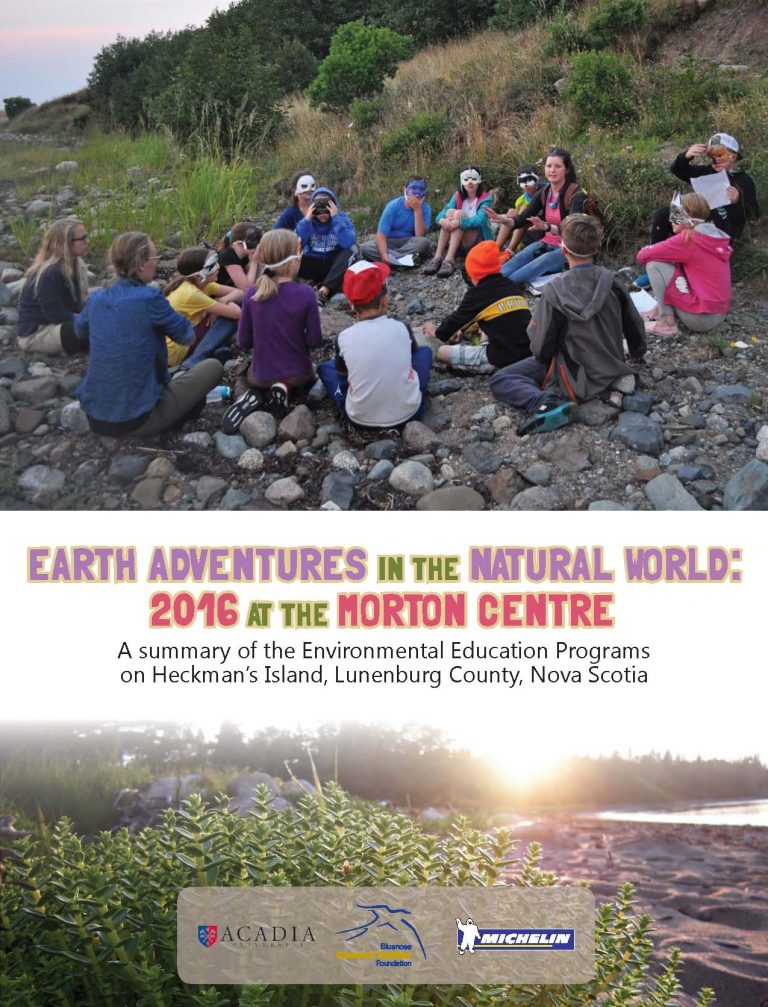
6 December 2016
Acadia participants at SETAC - Orlando
The Society of Environmental Toxicology and Chemistry World conference in Orlando, Florida was well represented by current Acadia students and alumni from Dr. O’Driscoll’s mercury research lab this year.
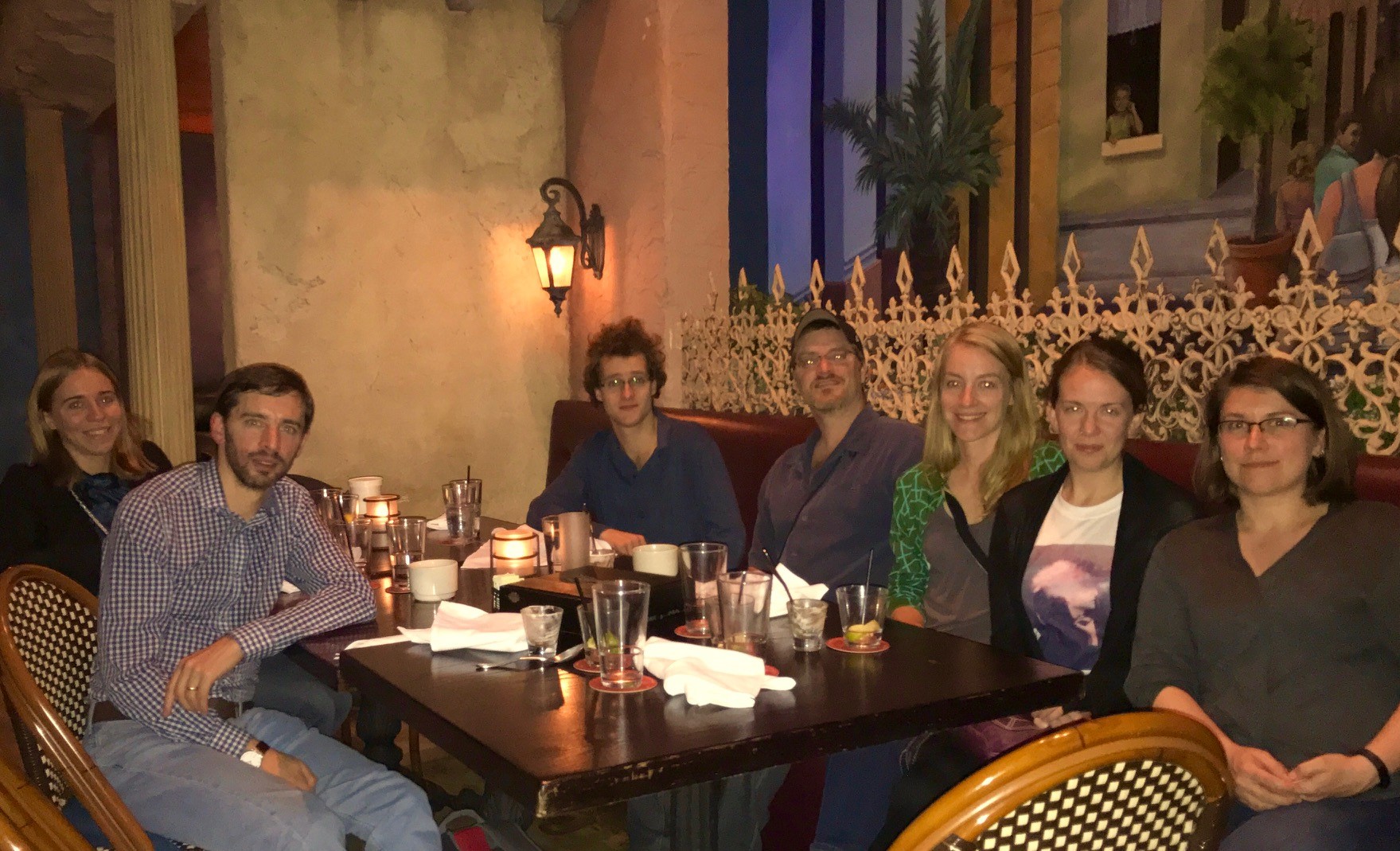
Pictured here are (left to right) Erika Holland, Tom Sizmur, Cardy Saunders, Nelson O'Driscoll, Sara Klapstein, Jocelyn Kickbush, Erin Mann.
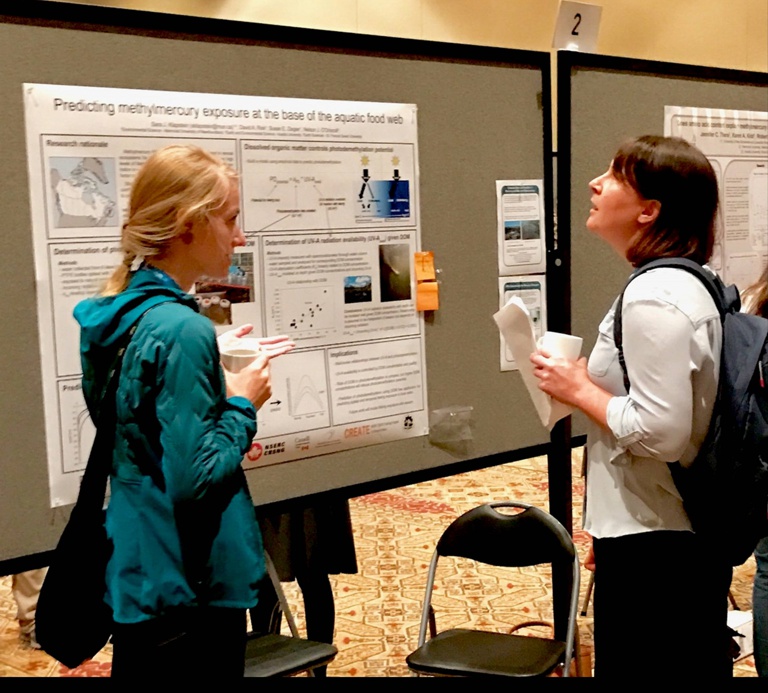
Sara Klapstein presented her PhD work on methylmercury photoreactions in Kejimkujik Park.
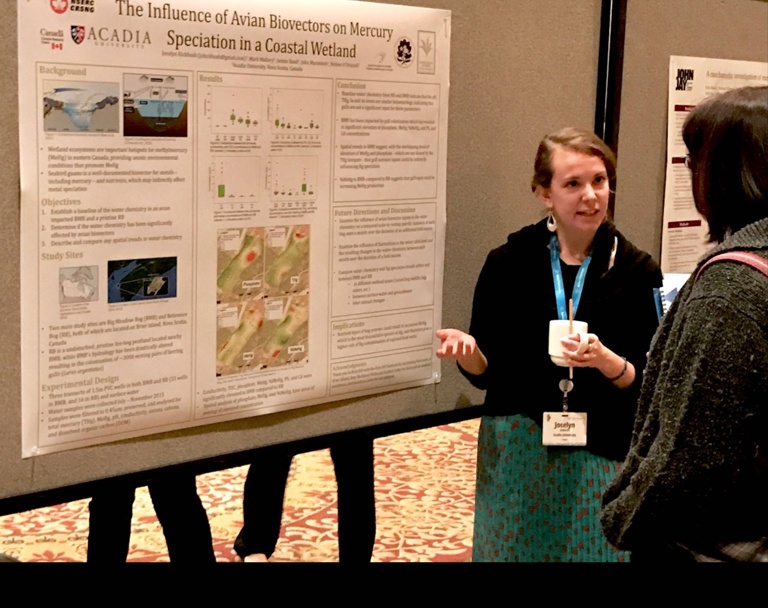
Jocelyn Kickbush presented her MSc work on mercury speciation in a Brier Island wetland influenced by bird guano.

Undergraduate researcher Cardy Saunders also presented his honours work on lichens as passive samplers of mercury in Nova Scotia.

Other lab alumni presenting at the conference were Dr. Tom Sizmur and Dr. Erin Mann (pictured above) presenting their mercury work performed at Acadia.
The mercury sessions co-chaired by Drs. O’Driscoll, Cai and Sizmur had many world experts presenting their recent findings. A special issue of the journal Environmental Sciences is being organized by Dr. O’Driscoll and co-chairs based on this session (tentative publication date Spring 2017). Other highlights of the conference included the Rachel Carson award which was presented to Dr. Schindler for his lifetime of work on whole-ecosystem research in the experimental lakes area (ELA). The students made great connections and enjoyed the weather in sunny Florida and the spectacle of the presidential election.
21 November 2016
Phosphorite study at Acadia University
(as published on the Acadia University website):
When Dr. Peir Pufahl studies rocks that have accumulated across the entire geological time scale stretching back 3.5 billion years, his work touches the life of your local farmer. Dr. Pufahl, professor of Sedimentary Geology in Acadia University’s Earth and Environmental Science Department, bridges the gap between science and industry with research that aims to improve global food security.
His international collaborations in Brazil, Australia, the UK, and the US also bring opportunities to Acadia undergraduate and graduate students. “It’s important to me that, once students leave my research group, they’ll be able to compete on the international stage,” he says.

As Canada’s only specialist in phosphorite – a sedimentary rock containing a high proportion of calcium phosphate – Dr. Pufahl is an international leader in phosphorite research. He is the sole international advisor to the Geological Survey in Brazil, where he has developed a federally funded initiative to try to find more phosphatic fertilizer deposits and so help Brazil feed its growing population of 200 million. He has done similar work in Western Australia.
“My research focuses on bioelemental sedimentary rocks,” he says. “From a scientific standpoint, these rocks are important because the precipitates of nutrient elements like phosphorus and iron are important for all living things. Phosphorus is required for energy conversion in cells – it’s the backbone of DNA. Iron is a building block of many proteins, and plants need iron to photosynthesize.”
By studying rocks through geological time, Dr. Pufahl seeks to better understand how the Earth’s system evolved. “When did oxygen evolve on Earth? How did the oceans change through time? What ramifications do these changes have for the evolution of life? We look at rocks from Precambrian times to the present to try to understand how phosphorus and iron have cycled throughout Earth’s history and given rise to the life we see today,” he says.
Working with industry
Dr. Pufahl works with colleagues worldwide to develop new exploration models specifically for phosphorus. “It’s satisfying to be able to work with industry to help them find more of these non-renewable resources,” he says. “My research and my research lab stand to make a real contribution in delineating not just Nova Scotia reserves for phosphorus but the Canadian phosphate reserve base, which is among the least known and understood in the industrialized world. Almost all our phosphorus is imported, much of it from countries in North Africa and the Middle East that have significant political unrest.”
Globally, phosphates have been described as “the gravest resource shortage you’ve never heard of,” Dr. Pufahl points out. “When you look at the Earth’s burgeoning population, it might be in the next 30 to 100 years that this really does threaten global food security if we don’t find more deposits.”
Dr. Pufahl is the only phosphate researcher who looks at phosphorus deposits scientifically and industrially in Canada.
Top-tier science
From around the world, PhDs, master’s students, post-doctoral fellows, and research associates come to Acadia to work in Dr. Pufahl’s lab. “We’re attracting the very best in the world,” he says. “By focusing on building these international collaborations and going after research money, we bring a tremendous amount of opportunity to everybody.” That strengthens the University and propels it down new and exciting pathways, he adds.
“We’re doing top-tier science at the international level,” he says. “We’re competing on the international stage. And that’s exceptionally important, because that’s how you build momentum to foster more collaborations, as we’ve been able to do over the years.”
Alongside Acadia’s global reach, Dr. Pufahl sees its local influence as invaluable. “We’re talking about developing phosphatic fertilizers in such a way that will directly benefit Nova Scotia agriculture,” he says. “Acadia lies in the agricultural heartland of Nova Scotia. That link to the local community, to Nova Scotia and to this region sets Acadia apart.”
A special place
Dr. Pufahl expresses gratitude to Acadia and his colleagues for the opportunity to do his research.
“Without that kind of support and understanding of what people are capable of, none of this is possible,” he says. “To have had the opportunity to do what colleagues at some large universities haven’t had the chance to pursue is incredible. Acadia is a special place.”
Recent News
Dr. Pufahl has been nominated for a 2016 Nova Scotia Discovery Award, Professional of Distinction. The award recognizes an individual who is a leading innovator and a role model for people who choose science as a career.
21 November 2016
Peir Pufahl takes up new editorial role

Dr. Peir Pufahl will share Chief Editorship with British colleague. In October Dr. Pufahl formally took over as Chief Editor for the journal Sedimentology, a role he will share with Dr. Nigel Mountney of the University of Leeds. Sedimentology is the flagship journal of the International Association of Sedimentologists and a leader in the Earth sciences. The journal’s current Impact Factor is 3.216, which places it 4 out of 47 in the subject area ‘Geology’. It has been over two decades since Canada has been home to an arm of the editorial office.
9 November 2016
Simon Poirier receives Imperial Oil internship
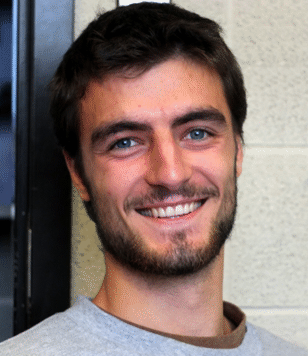 Simon Poirier has accepted a 4 month internship with Imperial Oil Limited in Calgary, Alberta. The position was offered to him after attending the Imperial Oil Recruiting short course. The course takes place in Calgary over a weekend in late September/early October. All travel and food expenses are paid for by Imperial Oil. This year the focus of the short course was basin analysis. His internship will begin in April, 2017, and he will be doing petroleum geoscience in the exploration division with supervisor R. Scott Parker.
Simon Poirier has accepted a 4 month internship with Imperial Oil Limited in Calgary, Alberta. The position was offered to him after attending the Imperial Oil Recruiting short course. The course takes place in Calgary over a weekend in late September/early October. All travel and food expenses are paid for by Imperial Oil. This year the focus of the short course was basin analysis. His internship will begin in April, 2017, and he will be doing petroleum geoscience in the exploration division with supervisor R. Scott Parker.
3 November 2016
Homecoming visit from Matt Kolsun, 2016

Acadia graduate of 2016, Matt Kolsun, joined the workforce in British Columbia three weeks after his convocation in May. He started his career with the British Columbia Ministry of Transportation & Infrastructure as a Field Service Engineering Aide. Matt works as a Quality Assurance Laboratory Technician for highway paving development located in Nelson, BC. His main tasks include the testing of density, oil content and gradation of the asphalt that are laid on the major highways throughout the Southern Interior of the province. So far during the summer of 2016, Matt has worked in Nakusp, Revelstoke and Sicamous.
Matt dropped by in the department when he was in Wolfville to update us on his activities.
2 November 2016
AUGC 2016
Congratulations to the Fletcher Geology Club who delivered an outstanding Atlantic Universities Geoscience Conference, 27-29 October 2016. Events started with the Thursday evening Challenge Bowl, hosted by the CSEG. The bowl returned to Acadia after an outstanding performance by Acadia students who won all of the rounds by a wide margin over teams from St. Francis Xavier, Saint Mary’s, UNB, and Memorial. Impressive! The prize is an all-expense-paid trip to Calgary in the spring for two Acadia students to participate in the national championship.

Rob Raeside expounding on Goldenville outcrops, Green Bay, Lunenburg County. Ambient temperature 1°, wind speed gale force 8. Photo by Anthony Chu.
Friday saw field trips head in three directions from Acadia with early starts in hopes of avoiding foul weather. First three vans headed west, led by Cliff Stanley, to East Kemptville to view the old tin mine, the recent drilling and the Brazil Lake pegmatite. In spite of wind and wet weather, several good specimens of spodumene and lepidolite were acquired. Half an hour later, a bus-load of students, including some visitors from Horton High School, headed to the South Shore to view the stratigraphy and deformation in the Meguma Supergroup at Green Bay, LaHave Islands, West Dublin and Feltzen South. Although the rain held off, the wind was fierce and the never-ending hike around the mushroom fold at Feltzen South achieved only two circuits before Rob Raeside, trip leader, could shout no more! This trip ended up in the relatively sheltered Aspotogan shore to view the effects of contact metamorphism in the rain. The final trip to depart stayed local, as Ian Spooner and Sandra Barr toured the eastern Annapolis Valley with stops on glacial deposits. deltaic deposits, siltstone, mudstone, slate, granite, sandstone, conglomerate, basalt and limestone, plus several beach stops to look at modern processes. Participants remained enthusiastic even after the rain began in the early afternoon.
In addition to the field trips, a fourth group of students participated in a short course on "Using seismic data: from discovery to early field development", where they learned how to apply geophysical methods to petroleum exploration replete with mapping out a faulted reservoir, estimating recoverable reserves, and designing the development of a producing oil field. The course was instructed by Dr. Fred Schroeder from Houston, Texas, and sponsored by AAPG.
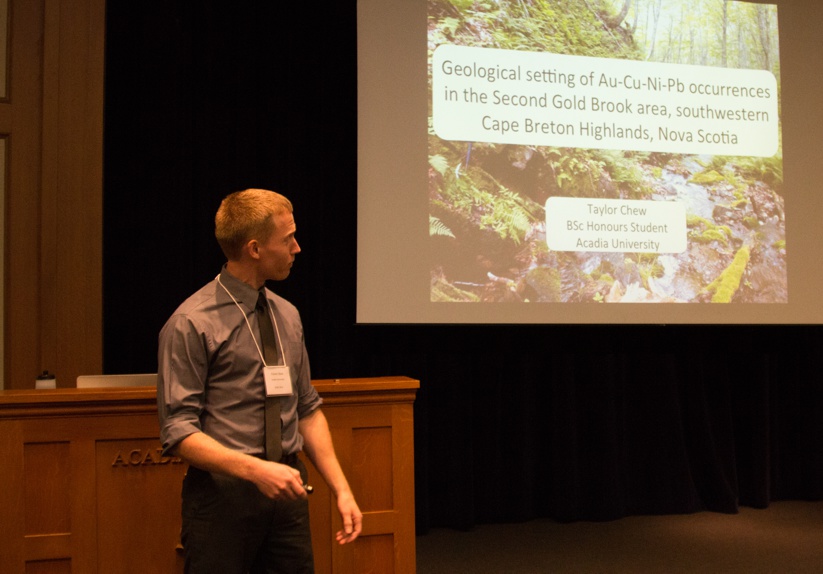
Taylor Chew, Acadia, presenting a paper on mineral occurrences in the Cape Breton Highlands. Photo: Anthony Chu.
Saturday was a busy day with 16 oral presentations and 6 poster presentations by students. Many people commented on the quality of the presentations - how can every one of these presentations by undergraduate students be of such quality, exceeding that of many professional conferences? Congratulations to all speakers and poster presenters - the diversity of topics and presentation styles was truly impressive. The day concluded with a closing banquet at the Old Orchard Inn, where we were given sage advice about what not to forget in our field kits by Amy Tizzard, winner of the APICS award at the 2002 AUGC, and now a contract geoscientist, based in Oxford, NS, but working in Namibia. Amy regaled us with her adventures, in Yukon, Australia, Kilimanjaro and Namibia.
Winners of the various awards were:
Science Atlantic Best Paper Award: Sean Murphy, Memorial University, for his paper "Three-dimensional morphological characterization of the trace fossil Parahaentzschelinia ardelia, Atoka Formation, Oklahoma"
Honourable mentions were made to the presentations by Alexander MacBeath and Nikki Bursey (both from Memorial University)
Imperial Oil Best Poster Award: Christopher Williams, Memorial University, for his poster "Rifted margin and sedimentary structure of the Porcupine Abyssal Plain, outboard of Goban Spur, southwest Ireland"
Frank Shea Award for best paper in Economic Geology: Taylor Chew, Acadia University, for his paper, "Geological setting of Au-Cu-Ni-Pb occurrences in the Second Gold Brook area, southwestern Cape Breton Highlands, Nova Scotia"
CSPG Award for best presentation of a petroleum geology-related paper: Erin Anderson, Dalhousie University, for her paper "Diagenetic effects and fluid flow along erosional boundaries in the Triassic Wolfville Formation at Rainy Cove, Nova Scotia"
CSEG Award for best presentation of a geophysics-related paper: Nicholas Lynch for his paper, Geophysical detection of reducing springs: A new approach.
AGS Environmental Geoscience Award: Fiona Henderson, for her paper "Predicting zones and potential sampling methods for elevated metal concentrations in urban soils, Halifax, Nova Scotia"

Winners of the hardware (from left): Erin Anderson, Dalhousie, CSPG Award; Taylor Chew (Acadia), Frank Shea Award; Christopher Williams, Memorial, Best Poster; Sean Murphy, Memorial, Science Atlantic Best Paper; Fiona Henderson, Dalhousie, AGS Environmental Geoscience award; Nicholas Lynch, Memorial, CSEG Award. Photo: Anthony Chu.
Following the announcement of awards for student presenters, several faculty members were recognized for their long-standing activity with Science Atlantic (and in earlier days APICS): Sandra Barr, David Lentz, Brendan Murphy, and Ian Spooner. Each professor received a Science Atlantic silver pin. Pins will also be awarded to Jarda Dostal, Milton Graves and Patrick Ryall at events in Halifax. Finally, Rob Raeside was inducted into the Science Atlantic Hall of Fame, recognizing his 34 years of activity in APICS and Science Atlantic, on the Earth Science Committee and as member and chair of the Board of Science Atlantic.

Grant Wach, chair Science Atlantic Earth Science Committee, Rob Raeside, Science Atlantic Hall of Fame, Lois Whitehead, Science Atlantic Executive Director. Photo: Anthony Chu.
Congratulations to the AUGC organizers - Lois Whitehead commented at the closing banquet that of the many Science Atlantic conferences she has seen happen, this was among the best organized. Big thanks to Sarah, Alex and crew for all your hard work on it.

Acadia participants at the closing banquet. Photo: Anthony Chu.
30 October 2016
E&ES wins Carson Cup
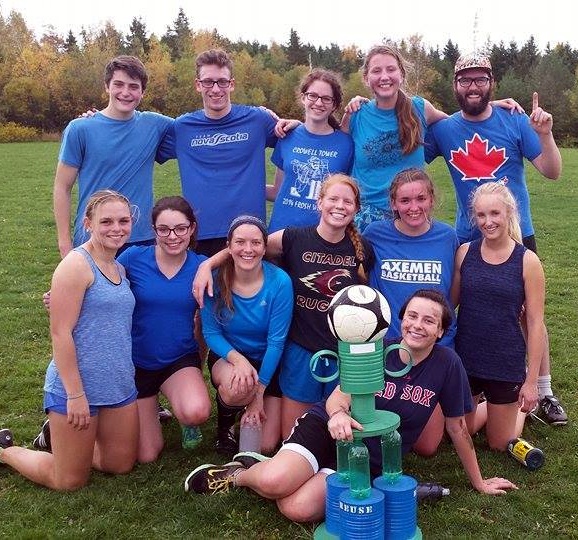
[Click on image for larger version.]
After two tightly matched halves against ESST, a few dramatic mud slides, and many battle cries, E&ES reclaimed the Carson Cup 3-2! Thank you to everyone who came out and participated!! Training for next year starts 5am tomorrow- hope yas like burpees!
Baillie Holmes (team captain)
22 October 2016
Taylor Chew featured in PDAC Core magazine
Acadia 4th year Geology Student Taylor Chew (second from left) was featured in the fall 2016 volume of Core, a publication of the Prospectors and Developers Association of Canada. The issue featured an article on the 10-year anniversary of S-IMEW which is the Student-Industry Mineral Exploration Workshop. Taylor was nominated by Acadia E&ES to attend S-IMEW in 2016. The Student-Industry Mineral Exploration Workshop was created by the PDAC in 2007 as a way to provide geology students with a unique opportunity to put their education in practice before entering the workforce.
[Click on image for larger version.]
10 October 2016
New outcrops in Gaspereau Lake
The hot dry summer and resulting low water levels in southern Nova Scotia gave Geol 3403 (igneous petrology) students a unique opportunity during a field trip on the afternoon of October 5th. The students were able to wander around on what is normally the bottom of Gaspereau Lake, in glorious Fall weather, to examine outcrops of biotite monzogranite (or is it granodiorite?) that are typically deep underwater. The striking scenery leaves no doubt that granite underlies the area, and shows what large areas of Nova Scotia would look like without all those Quaternary sediments and vegetation.
Photograph by Renee LeBlanc [click on image for larger version].
6 October 2016
Sara Klapstein at the Canadian Ecotoxicity Workshop in Edmonton
Sara Klapstein, a PhD candidate in Dr. O’Driscoll’s Environmental Biogeochemistry Lab, attended the 43rd Canadian Ecotoxicity Workshop in Edmonton - September 25-28th. This was a great networking experience with ecotoxicologists all across Canada. She attended several mentor events and discussed her research with industry and federal scientists alike! Sara co-chaired a session and discussion panel: “Effective Communication in Ecotoxicology” with Guy Gilron (Borealis Environmental Consulting Inc.) which focused on effective presentation styles and bridging the gap between public and scientific understanding. She also received a cash award for her poster presentation: “Risk of methylmercury exposure in freshwater lakes”.
3 October 2016
Evangeline Beach - a fine day for a clastic rocks field trip
Image by Professor Ian Spooner
A fine sunny day saw the third year class visit Evangeline Beach in their the second lab period in the Clastic Rocks & Petroleum Geology course. They viewed the Horton Group sedimentary rocks - braided river deposits, including conglomerate shed off the South Mountain in the Triassic Period.
23 September 2016
A new look for Huggins Science Hall
A new look for Huggins
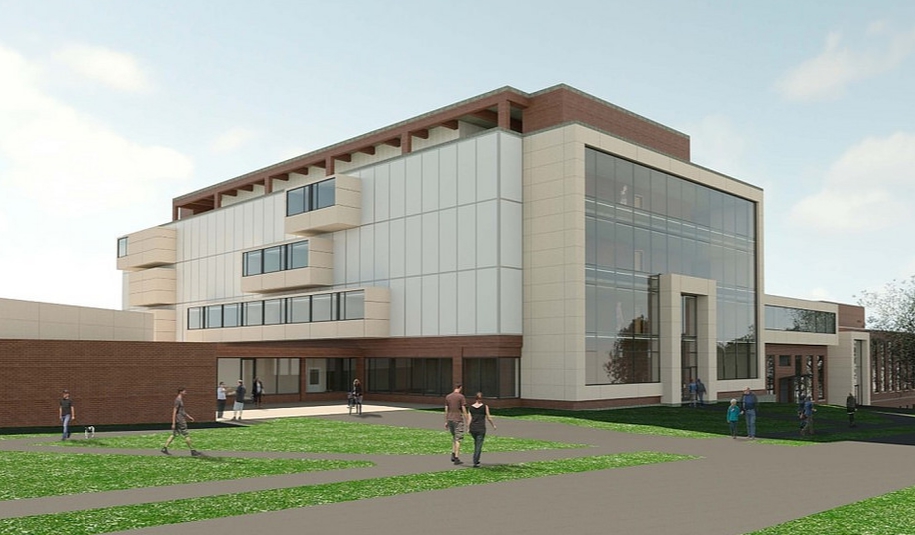
Funding of $15.98M was announced by the Honourable Scott Brison, Kings-Hants MP, on behalf of the Honourable Navdeep Bains, Minister of Innovation, Science and Economic Development, and by the Honourable Kelly Regan, Nova Scotia Minister of Labour and Advanced Education.
Although details are still forthcoming, a Flickr Stream shows several artist's interpretations of the renewed complex, with an expanded shell on Huggins, an "innovation pavilion" in the space between Huggins and Elliott and a full renovation of Elliott Hall. At the announcement, in a crowded and very hot Elliott 221, much comment was made about the new and improved heating and air conditioning systems.
See also the formal university announcement.
15 September 2016
Field School 2016
The first two-thirds of Geol 4083 (Senior Field School) was completed between August 28-September 5 based at the Gaelic College in St. Anns, Cape Breton Island. This year's group is pictured above with instructor Sandra Barr at the Aspy Look-off during the Cabot Trail field trip - the hanging valley in the background illustrates that field school is not entirely about "basement rocks". Missing from the photograph - Rob Raeside who had to return to Wolfville for university duties.
The third component of the course, an independent mapping project in the Gaspereau Mountain area near Wolfville, will be completed in early October.
7 September 2016
Yay Zircons!
Acadia MSc students Jon Shute (left) and Gabriel Santos recently spent two days with Dr. Deanne van Rooyen at Cape Breton University, learning how to pick zircon grains from crushed rock samples for radiometric dating. Dr. van Rooyen is Assistant Professor of Geology in the School of Science & Technology at Cape Breton University and is a recently appointed adjunct professor at Acadia University. Her research focuses on structural and metamorphic petrology, as well as determining the ages of rocks.
26 August 2016
Cannibal sharks in a paper by Peir Pufahl
Professor Peir Pufahl is a co-author on a paper just published in the journal Palaeontology that describes “filial cannibalism” in sharks 300 million years ago. A tiny tooth in fossil poo suggest Orthacanthus sharks ate their young. The coprolite sample collected by University of Bristol MSc student Aodhan Ó Gogáin, now a PhD candidate at Trinity College Dublin, is part of a wider investigation into prehistoric fish along the swampy coast of ancient New Brunswick. This macabre discovery is featured on the BBC website, and in the Irish Independent and Washington Post. Read the full story.
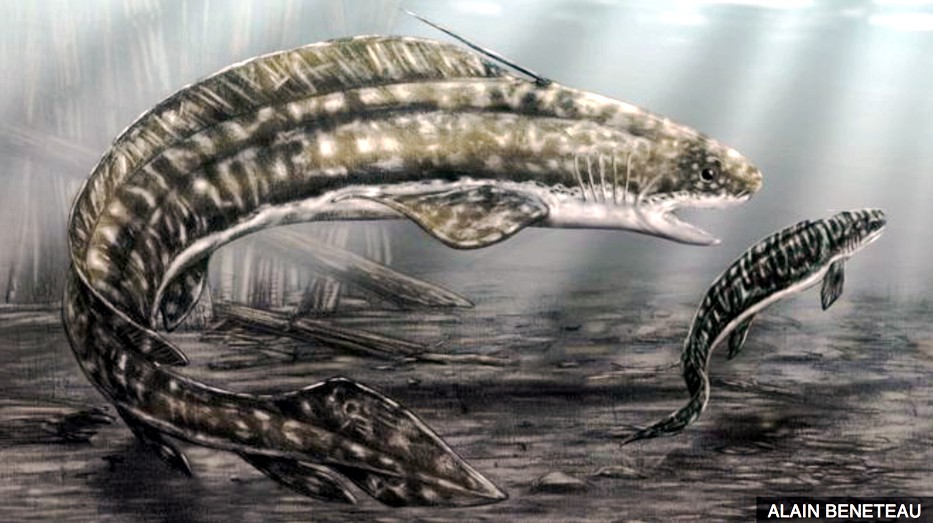
17 August 2016
Federal Environment Minister visits Acadia's CARE labs
Acadia University’s environmental science labs were under a microscope themselves Monday as some of the university’s leading research projects were examined by federal Environment and Climate Change Minister Catherine McKenna.
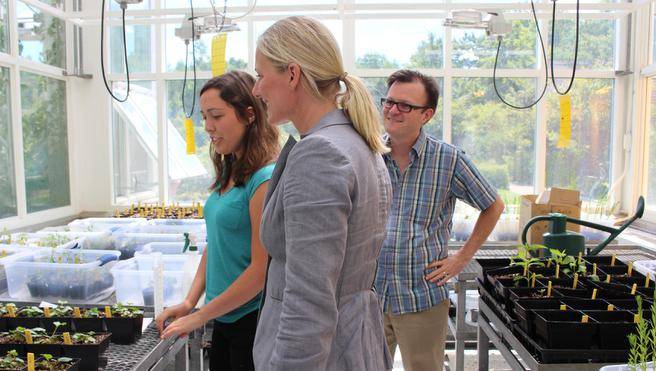
Fourth-year student Sarah Fancy showing Ms. McKenna her work on the Eastern Mountain Avens
McKenna called the research students and faculty at the Wolfville campus her biggest allies as she took time to visit the K.C. Irving Environmental Science Centre and the Harriet Irving Botanical Gardens.
“We absolutely need more students who are studying environmental science. We need researchers of tomorrow … who care passionately about taking action to tackle climate change,” she said. “When we look at climate change we actually don’t know what the impacts are going to be. We’re seeing a huge change to the eco-system and biodiversity.”
 Dr. John Murimboh, Chemistry, explaining lab work to Ms McKenna and MP Scott Brison
Dr. John Murimboh, Chemistry, explaining lab work to Ms McKenna and MP Scott Brison
She and Treasury Board President Scott Brison were led through the greenhouse research centre and science labs by university president Ray Ivany. They met students and faculty as well as top administrators. Ivany said the university’s environmental programs are some of the fastest growing program areas.
“We have the agriculture sector that is here, so that opens up a whole range of possibilities. We’ve got the Bay of Fundy, and the Minas Basin specifically, where we do a lot of research on tidal as well as the species that are in the mud and in the water. And then you’ve have Keji and a whole range of ecosystems throughout the Valley, so there’s no shortage of really important environmental issues right in our back yard,” said Ivany.
Research is multi-disciplinary — biology, chemistry, physics and environmental science — providing rich opportunities pertaining to agriculture, forests wetlands, geology and more in the area's natural world.
“It’s not just a small little place doing a little bit of research,” said Director of Research Dr. David Kristie. “At one time we had 25-35 honours students doing research. That’s more than you’d find at University of Toronto.” Kristie said the difference is that Acadia doesn’t have many PhD students doing research. “So it moves down a notch to masters and undergrads doing it.”
In the past week, Kristie has started a flip album highlighting the early stages of research topics so members of the public who visit the centre’s garden room can see for themselves.
(from The Chronicle Herald)
10 August 2016
Cliff Stanley and Sandra Barr awarded NS Mineral Incentive Research Grants
The Nova Scotia Department of Natural Resources (NSDNR) recently awarded Research Grants to two researchers from Acadia University’s Department of Earth and Environmental Science from the Province’s Mineral Incentive Program. These grants were established to help fund research that supports and encourages mineral exploration and development in Nova Scotia. The research must be undertaken in Nova Scotia by university-based researcher(s).
Dr. Cliff Stanley is studying the Lithogeochemistry of the Dominique Sn-Zn-Cu-Pb-Ag Vein Prospect, Yarmouth County, supported by a grant of $15,000 and at the opposite end of the province, Dr. Sandra Barr has been awarded a grant of $4800 to help support her project on the Geological Setting of Au-Cu-Fe-Ni Occurrences in the Second Gold Brook Area, Western Cape Breton Island.
25 July 2016
Mercury research, croissants, and labour reform strikes in France
by David Kristie
When undergraduate students profess an interest in conducting research, more senior students often take great delight in highlighting some of the difficulties of research; hard to satisfy supervisors, experiments that won’t work, unexpected setbacks, and endless revisions of reports and theses. But an undeniable reward for perseverance and hard work is the opportunity to see your name in print and communicating your hard won new knowledge to other like-minded students and scientists via publications and conferences. Specialized national and international conferences provide a collaborative environment where experts and students alike come together to share research findings, make new contacts, and possibly enjoy a brew (or wine in this case).
Students in Dr Nelson O’Driscoll’s Environmental Biogeochemistry Lab (which has a focus on mercury) are fortunate in that Dr O'Driscoll is a firm believer in sending students to Canadian, and even the occasional international conference to communicate their findings. Dr O’Driscoll’s research focuses on the transformation and accumulation of mercury species in the environment, and is considered to be one of the foremost mercury labs in Canada. Dr O’Driscoll’s lab is part of the Centre for Analytical Research in the Environment (CARE) which is located in the research wing of the KC Irving Environmental Science Centre.
Recently two of Dr O'Driscoll's graduate students had the opportunity to present their research at the Society of Environmental Toxicology and Chemistry (SETAC) Europe 26th Annual Meeting in Nantes, France (May 22-26, 2016). While France was in the midst of public service sector strikes that disrupted train travel and pretty much any public service run by unions, the strikes did not detract from the beauty of the countryside, the fabulous food, or the quality of French wine, and of course, the learning and networking value of the conference itself.

Jocelyn Kickbush, an MSc student and Arthur Irving Scholar presented her work on the Influence of Avian Biovectors on Mercury Speciation in a Coastal Wetland. While wetlands are known as hotspots for transforming mercury into its most toxic and bioavailable form (methylmercury), influences on this transformation in wetlands are not well understood. By studying a coastal wetland on Brier Island, Nova Scotia, which has been colonized by ~6000 seagulls, not only is the role of seagulls as biovectors examined, but also the indirect influence their nutrient input – from sources such as guano, carcasses, and diet - have on mercury’s transformation into methylmercury.
Sara Klapstein gave a platform presentation entitled Linking variation in natural solar radiation with seasonal methylmercury dynamics in freshwater lake systems and a poster entitled Dissolved organic matter controls mercury photoreactions in freshwater lakes. This combination of work is based on 3 years of canoeing (and research) in Kejimkujik National Park. Her research focuses on photoreactions between methylmercury, (the toxic form of mercury we ingest through food, primarily fish) and carbon in freshwater lakes. Sara is a PhD candidate from Memorial University of Newfoundland but she spends the majority of her time here at Acadia, working with Dr O'Driscoll who is her co-advisor.
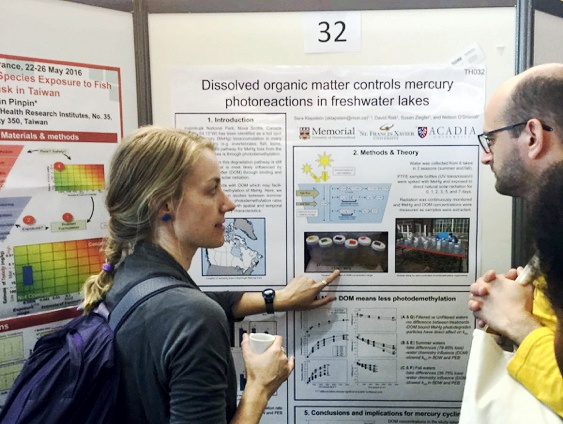 Sara also recently attended the Canadian Society for Chemistry 99th Conference and Exhibition in Halifax where she won the Environment Division Oral Presentation Award for her presentation: Mercury photoreactions in freshwater lakes are controlled by dissolved organic matter in a Chemical Cycling in Natural Environments session. This diverse session was composed of scientists and students from Eastern Canada and highlighted some of the major biogeochemistry questions facing the many different ecotypes across Canada.
Sara also recently attended the Canadian Society for Chemistry 99th Conference and Exhibition in Halifax where she won the Environment Division Oral Presentation Award for her presentation: Mercury photoreactions in freshwater lakes are controlled by dissolved organic matter in a Chemical Cycling in Natural Environments session. This diverse session was composed of scientists and students from Eastern Canada and highlighted some of the major biogeochemistry questions facing the many different ecotypes across Canada.
Undergraduate researchers in Dr O’Driscoll’s lab Include Honours student Cardy Saunders (Biol ‘17), who is collecting lichens from across Nova Scotia to analyze for mercury content, and Arthur Irving Scholar Rachel Clarke (ENVS ‘18), who is learning the ropes and helping out with various projects. Both are dreaming of attending their first international conference.
22 July 2016
Acadia E&ES now using drones!
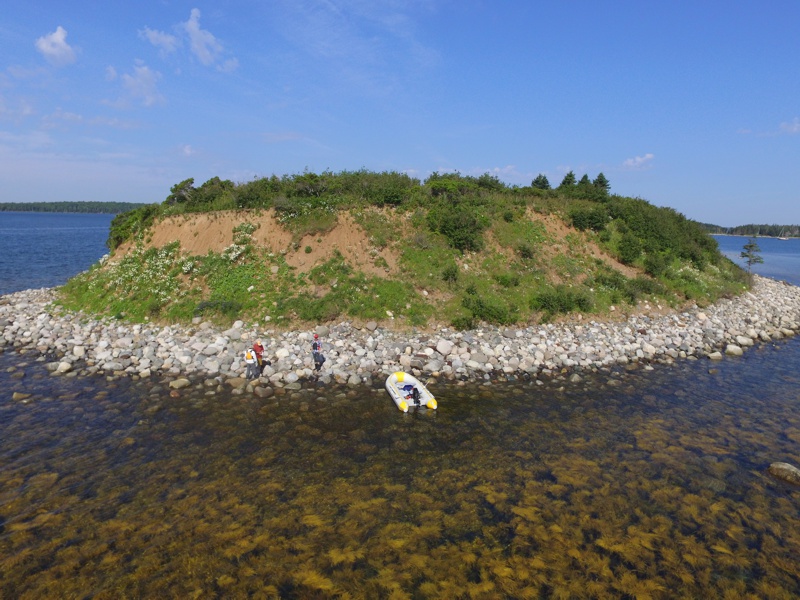
Acadia Earth and Environmental Science recently purchased a Phantom 3 drone for use in research and teaching. The photos below were taken by the drone while Ian Spooner (orange hat!) and Jerry Osborn (University of Calgary) were in the Mahone Bay Islands doing research for a book chapter on the Landscapes of Eastern Canada. The drone was used to take aerial images of the eroding cliffs of drowned drumlins in Mahone Bay in order to interpret sediment stratigraphy better.
Click here for another view (3 MB file).
19 July 2016
Alex Squires awarded Nova Scotia Innovation and Research Graduate Scholarship
Congratulations to Alexandra Squires, who has been awarded a scholarship in the Nova Scotia Innovation and Research Graduate Scholarship (Master's) competition under the priority of Resource Sectors. As noted in the award letter: "These are highly prestigious awards and being a recipient is a clear testament to your scholarship and abilities as a researcher." The award is for one year, with the possibility of a one-year renewal, and is in support of Alex's MSc thesis work which she will begin in September under the supervision of Peir Pufahl. Alex is currently working as an Outreach Programs Assistants for Mining Matters at the PDAC.
18 July 2016
NSERC Discovery Grants to Sandra Barr and Ian Spooner
Discovery Grant Awards from the Natural Sciences and Engineering Research Council of Canada (NSERC) were announced on June 23, 2016. Both applicants, Sandra Barr and Ian Spooner from the Earth and Environmental Science department were successful in their applications.
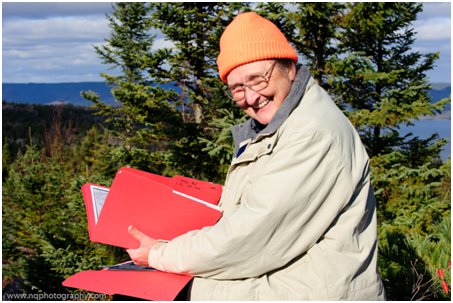
Dr. Sandra Barr received a 5 year Award of $145,000.00 for her project, "Building mountain belts - the Appalachian model". In the application she wrote:
Each mountain belt on Earth is unique, but similar processes likely took place in the formation of all. One of those processes is the accretion of exotic fragments or terranes. My research program focuses on identifying such fragments in the northern part of the Appalachian mountain belt, interpreting from where on the Earth they were derived, and understanding how, when, and why they were attached to ancestral North America. My working model recognizes fragments in the northern Appalachian and correlative belts in Europe derived from three separate microcontinents named Meguma, Avalonia, and Ganderia.
We have made much progress toward understanding these fragments, but problems remain. This proposal focuses on two specific problem areas: (1) the part of Ganderia in central Cape Breton Island and (2) the part of Avalonia in northern mainland Nova Scotia. I will use field mapping as a basis to better define rock units, followed by mineral, textural, and chemical studies, dating, and isotopic analyses of carefully collected representative samples to decipher the ages and origins of the rocks in these areas.
This work is important to geoscientists who work in areas from which components of the mountain belt may have been derived and/or to which former components may have been dispersed after the break-up of Pangaea. More broadly, the work is important to those who are trying to understand the fundamental processes of mountain building as exemplified in the northern Appalachian orogen. The relevance of my work is demonstrated by the extent of my collaborations with geoscientists from not only Canada but also the USA, UK, Spain, France, and Germany. My research involves students at both the undergraduate and graduate (MSc) levels and hence funding for students is the largest component of my budget. My students learn how to interpret rocks in the field, acquire and use analytical data, make public presentations, and write scientific papers.
We anticipate that the new results, integrated with those from previous work and from other areas, will lead to a definitive and internally consistent model for northern Appalachian mountain building, with broad applicability to other mountain belts. Such understanding should lead to increased and more successful mineral exploration programs, especially if, as we anticipate, rock units related to those in mineral-rich areas in central Newfoundland and New Brunswick can be demonstrated to be present in Cape Breton Island.

Dr. Ian Spooner received an award for a project on the influence of environmental stressors on metal sequestration in shallow lakes. In his application, he wrote:
Small (< 40 ha), shallow (< 10 m) moderately productive lakes are a common and integral component of Atlantic Canada and are important recreational, municipal and ecological resources. Lake management has focused on the prevention of the deterioration of water quality, and recent paleolimnological studies that have focused on lake acidification and nutrient loading have provided important context for management. The proposed research will expand upon that research concentrating on metal sequestration and mobility in lakebed sediments. Lead, arsenic, mercury and uranium are toxic metals of interest in Atlantic Canada. Accumulation of these metals in lakebed sediments is a common concern along with increased bioavailability associated with changing environmental conditions. A 300-year history of mining and logging throughout Nova Scotia has had a significant environmental impact on lakes but separating anthropogenic contamination associated with these practices from the natural input of metals has been problematic.
In this research sediment cores from lakes will be used to better understand the sources of metals in lakebed sediments and the factors that influence mobility and bioavailability. Stable isotopes, Xray fluorescence, ICPMS, and a variety of abiotic proxies coupled with radiometric dating (14C and 210Pb) will be applied to lakebed sediment cores to reconstruct 500 year records of lake water quality and chemistry in order to decouple natural variability from anthropogenic influences. Research will focus on the identification of elements and isotopic analyses best suited to determining the effects of development. As well, the role of lakebed sediment composition and low oxygen levels in metal sequestration and mobility will be explored. This research is collaborative and will be integrated with bioaccumulation and toxicology research already in progress by Dr. M. Mallory and Dr. N. O'Driscoll at Acadia University. Established partners in this research initiative include Ducks Unlimited Canada, Halifax Regional Municipality, and Halifax Water.
The proposed research program will develop strategies that will facilitate effective resource management and help determine which lakes and water supply reservoirs are most susceptible to metal bioavailability and mobility. If environmental assessment of lakes is to be effective and if sustainable management and restoration is to be successful, cost-effective, time-efficient and readily accessible methods for the reliable determination of the effects of environmental change and watershed development on these lakes are required. The field and laboratory techniques required in this research program will train students, are transferrable and are relatively inexpensive; technology transfer to both the public and private sector will be an important component of this research.
24 June 2016
Taylor Chew - APGO Photo Contest winner
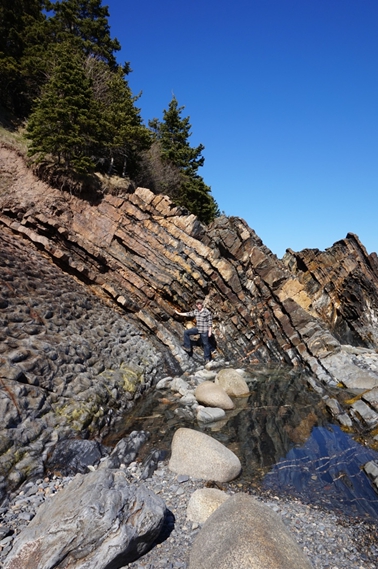
Congratulations to Acadia student Taylor Chew, the winner of the 2016 photo contest of the Association of Professional Geoscientists of Ontario (APGO). APGO members voted and Taylor’s photograph was the winner. Taylor is a Student Member of the APGO. He has a degree in geography from the University of Waterloo and a degree in geology from Acadia University. He is employed by the Nova Scotia Department of Natural Resources for the summer as a Geological Assistant, and his BSc honours thesis on the geological setting of the Gold Brook mineral occurrences in Cape Breton Island is in progress. His photo that won APGO's 2016 Photo Contest is a recent one that was taken on a class field trip with Dr. Cliff Stanley on the south coast of Nova Scotia. It shows an anticline of black slate from the Halifax Formation near Lunenburg, Nova Scotia, a known source for gold deposits in quartz veins.
15 June 2016
SEG Scholarship for Shane Higbee
The Society of Economic Geologist (SEG) supports graduate students conducting research and pursuing master's or doctoral degrees in Economic Geology. Shane has been awarded $1400 from the Society of Economic Geologists Canadian Foundation (SEGCF) to help support his research topic "Understanding interactions between partial digestion reagents and soil mineral matrices in exploration geochemistry" by offsetting suitable field and analytical expenses.
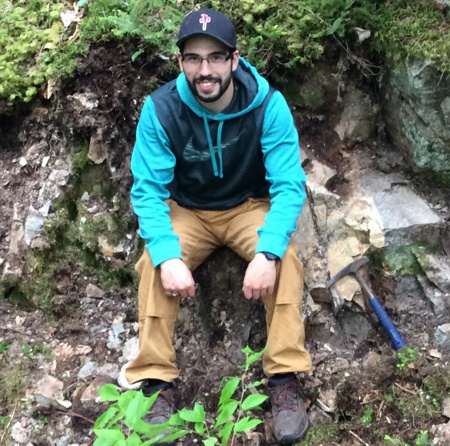
Behind Shane is an aphanitic quartz porphyry dyke in sharp contact with quartz that grades into the biotite-muscovite monzogranite host. Nearby Sn, Cu, Pb, Zn, As, Bi and U mineralization has been found in veins, pegmatite and greisen alteration zones within the mozogranite. The dyke cuts through the alteration zones in the New Ross area.
6 June 2016
IAS Meeting in Marrakech
Laura MacNeil and Dr. Peir Pufahl from the Department of Earth and Environmental Science presented talks at the 32nd International Association of Sedimentologists meeting in Marrakech, Morocco in late May.
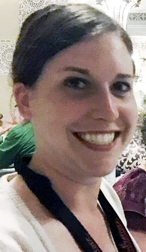
Laura’s talk was focused on her M.Sc. thesis research and was entitled "Sedimentology and paleoceanography of the Early Carboniferous Windsor Group, Nova Scotia: implications for the formation of saline giants”. It was very well received with many conference attendees commenting on how surprised they were that a M.Sc. student could prepare and discuss such a comprehensive piece of science. The focus of Peir’s talk was on the development and exploration of economic sedimentary phosphorite, which was appropriate given Morocco contains 72% of the world’s phosphate reserve base.

The central market in the old city of Marrakech and some of the souks.
31 May 2016
Graduation 2016
40 Graduates in Earth and Environmental Science at May Graduation
On one of the coldest days of spring, graduating students and proud family members battled the winds of May at Acadia's graduation. In all, 37 BSc degrees and 3 MSc degrees were recognised from Earth & Environmental Science at the May convocation at Acadia, comprising 3 MSc (Geology), 4 BSc Honours (Environmental Science), 2 BSc honours (Geology), 1 BSc honours (Biology/Geology), 20 BSc (Geology), 1 BSc (Environmental Geoscience), and 8 BSc (Environmental Science).
Particular honour went to Sarah Adams, winner of the University Medal in Environmental Science, and Alexandra Squires, winner of the University Medals in Geology and Spanish, and recipient of the Mining Society of Nova Scotia Centennial Medal.
Pictured at the E&ES pre-grad breakfast in the KC Irving Environmental Science Centre: (back row, from left) Alex Aquires, Matt Kolsun, Dewey Dunnington, Max Turner, Asia Reid, Mac Wade, Erik Ardley, Sonya Ardley, Michael Brophy, (front row, from left) Sarah Adams, Hannah Windatt, Jolene Ashini, Kelsey McInnis, Rebecca Woodcock, Regan Maloney, Cole Thompson, Thora Christensen, Chloe Raitt, David Maguire.
Click on picture for large version.
17 May 2015
Anne-Marie Ryan honoured with Dalhousie Teaching Award
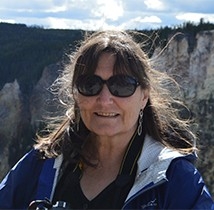
Acadia graduate Anne Marie Ryan (MSc Geology 1979) has received the top teaching award at Dalhousie University, the Alumni Association Award of Excellence for Teaching. Anne-Marie is being recognized for her leadership in developing programs for early career faculty within the Faculty of Science and the expansion to a “Community of Teaching Practice, Faculty of Science,” as well as her her scholarly contributions to pedagogic research. One student noted that, “Anne Marie is a great prof whose dedication and love for geology is evident through her teaching styles and enthusiasm.” Acadia students in Geol 3403 (Igneous Petrology) still benefit from Anne Marie's MSc thesis on the Gillis Mountain pluton by studying samples from her thesis collection as a Nova Scotian example of an I-type granitoid suite.
17 May 2016
Carbonate Sedimentology Field School
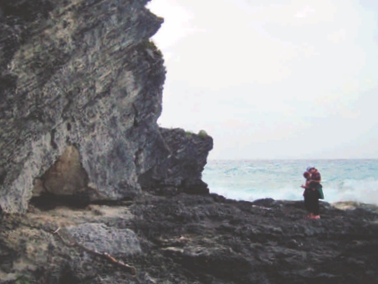
Stephanie and Alex logging a stratigraphic section through aeolianite on the south shore of Bermuda
Eleven Acadia students learned about the geology of petroleum systems in the 2016 Carbonate Sedimentology Field School. Exercises in Nova Scotia and Bermuda focused on interpreting carbonate depositional environments, limestone geochemistry, and reservoir development. The involvement of Drs. Nick Tosca from the University of Oxford and Justin Strauss from Dartmouth College enhanced this exceptional student experience. We thank Imperial Oil and the Offshore Energy Research Association of Nova Scotia for their generosity and support.
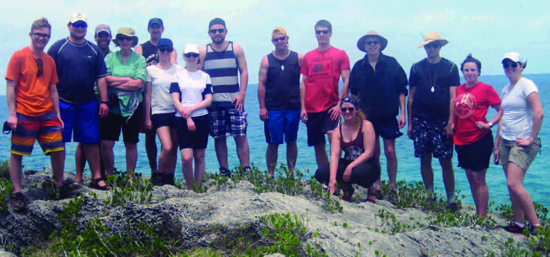
The whole group on the outcrop in Bermuda. Left to right, Max Chipman, David Maguire, Nick Tosca (Oxford), Pam Frail (Acadia), Juston Strauss (Dartmouth), Kelsey McInnis, Margot Aldis, Pat Smith, Jon Shute, Dillon Langelaan, Stephanie Todd, Mike Robertson (Acadia), Gareth Davis, Carol Davis, Alex Squires.
16 May 2016
Geology Field School 2016
The Geology field school ran from 26 April to 7 May, the first week from Acadia and the second week at Camp Geddie, Merigomish, Nova Scotia. Rocks examined ranged from Precambrian to Triassic, with exercises involving mapping and logging sections in streams, coastlines, barrens and core. Weather through the field school varied with some warm days early on, cold weather at Merigomish, and plenty of rain. And for the record, it snowed at Fall Brook.
10 May 2016
Environmental Science Field School - 2016

Twelve students completed the Environmental Science field school, April/May 2016. In the ENVS field school students receive practical field skills and hands-on training from Acadia professors and government scientists. The students had an excellent field school program this year covering many environmentally relevant topics including: geological mapping, GIS, forest productivity and forestry, field and lab QA/QC training, seabird dissection and contamination analysis, fungal collection, and invertebrate collection and identification. Mostly sunny days and a lot of good fun!
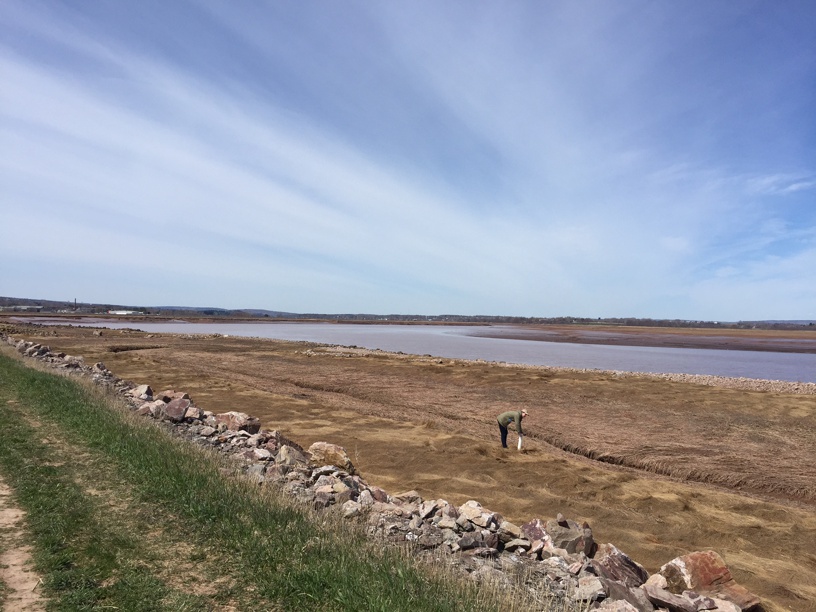
Sampling salt marsh cores around a sewage effluent site to quantify effects on rooting zones and associated fungi - exercise by Dr. Nelson O'Driscoll and Dr. Allison Walker.
9 May 2016
Sandra Barr appointed as President of CFES
At the Annual General Meeting of the Canadian Federation of Earth Sciences in Ottawa on 15-16 April Dr. Sandra Barr was appointed as president. The CFES is a body that pulls together many of the geologically oriented societies and organizations in Canada, and describes itself as the coordinated voice of Canada's Earth Science community, ensuring that decision makers and the public understand the contributions of Earth Science to Canadian Society and the economy. Sandra has been president-elect for the past three years, and replaces Scott Swinden, also resident in Wolfville, who now becomes past president.
19 April 2016
E&ES Year-end Banquet
The Earth and Environmental Science year-end banquet featured fine fare, good food, and several awards. Organized by ESSA, over 60 people from the department enjoyed a wide choice of food groups in the Legion Hall.

Sonya Ardley and Thora Christensen obviously spent much time analyzing graded bedding in order to construct their "layer cake".
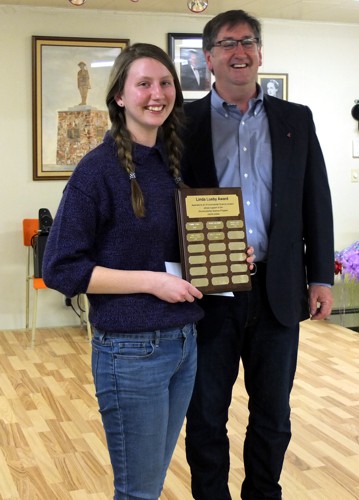
The Linda Lusby Award was presented to Baillie Holmes.
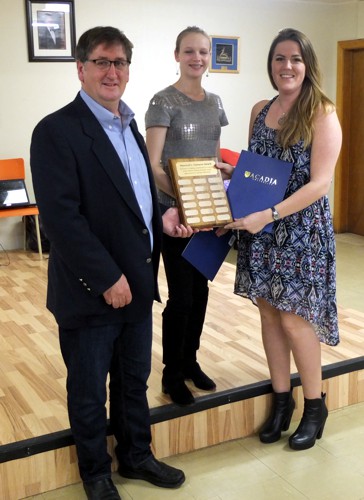
The Harcourt Cameron Award was presented jointly to Katie McCulloch and Alex Squires.
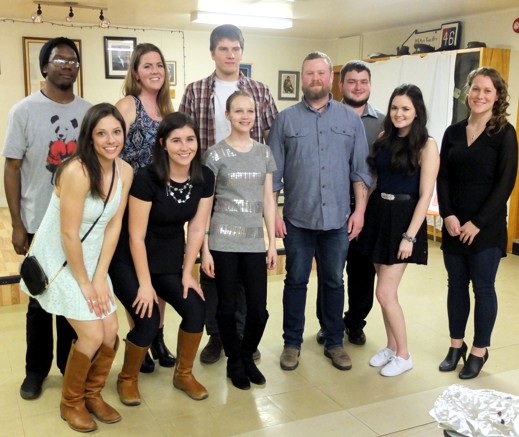
Members of the retiring and incoming Fletcher Club executives were recognised: (back row) Calvin Pratt, outgoing faculty meeting rep; Alex Squires, outgoing president; Dillon Langelaan (incoming treasurer); David Maguire (outgoing treasurer); (front row) Asia Reid (outgoing vice-president); Allison MacDougall (incoming events coordinator); Katie McCulloch (outgoing events coordinator), Erik Petersen (incoming president); Brooklyn Heron (incoming vice-president), Heather McGuire (incoming faculty meeting rep)
12 April 2016
Acadia students participate in the Ritual of the Calling Geoscience Ring Ceremony
Seventeen Acadia Geology and Environmental Geoscience graduates participated in a ceremony held at the Dalhousie Faculty Club on April 8 to receive their sterling silver ‘Geoscience Rings”.
[Click on image for larger version]
From left to right: Alex Squires, Shane Higbee, Joel Robinson, Cole Thompson, Gareth Davis, Taylor Chew, Katie McCulloch, Alx Maenza, David Maguire, Dewey Dunnington, Jolene Ashini, Mackenzie Wade, Rebecca Woodcock, Sarah Thompson, Margot Aldis, Asia Reid, Kelsey McInnis.
12 April 2016
Acadia University participants at the annual meeting of the Northeastern section of the Geological Society of America (NEGSA)
Faculty and students from Acadia were among the 1000 participants at the annual meeting of the Northeastern section of the Geological Society of America (NEGSA) held in Albany, New York, March 20-23rd, 2016. Ian Spooner and MSc student Dewey Dunnington both presented talks on their joint research with adjunct professor Chris White (NS Department of Natural Resources): Dewey’s talk was based on his MSc thesis research on water quality at Alta Lake in Whistler, BC, and Ian spoke more generally on research work carried out to investigate metal sequestration, mobility, and biomobility in lakes in Nova Scotia. Sandra Barr gave an oral presentation in a special session on applications of geochemistry and geochronology to understanding tectonic processes. Her presentation, co-authored with Acadia MSc students Lisa Slaman and Jonathan Shute, Chris White (NSDNR), and Deanne Van Rooyen (Cape Breton University), focused on on-going work in the Cheticamp area of the Cape Breton Highlands. She also co-authored a poster presentation with Chris White and Spanish colleagues Soren Jenson and Teodoro Palacios on microfossils from the global stratotype for the Precambrian-Cambrian boundary in Newfoundland. The NEGSA is a topically diverse meeting that provides excellent opportunities for building collaborations with geoscientists and potential graduate students in New England with research interests connected by geographic proximity to those in Nova Scotia.
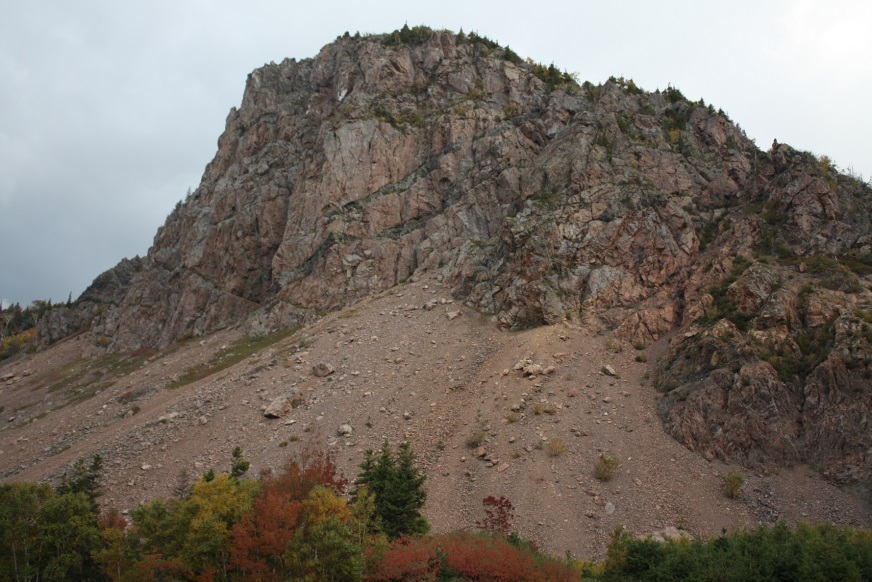
Grand Falaise, Cape Breton Island, the focus of the presentation by Sandra Barr and co-authors at the NEGSA meeting.
31 March 2016
Acadia University students sweep up at Science Atlantic Environment Conference
Many prizes were awarded to current Acadia students and alumni at the Science Atlantic Environment Conference in Moncton, New Brunswick, on the weekend of 18-19 March. Presentations at the conference were made by Thora Christensen, Sonya Ardley, and graduate students Sara Klapstein and Cardy Saunders. Sonya received the first prize for undergraduate oral presentations for her work with Dr. Jennie Rand on water quality treatments for a carrot processing facility. Sara received the science communication top prize for her work with Dr O'Driscoll on mercury photo-reactions. Also Emily Walker (ENVS graduate from 2014) won first prize for graduate oral presentation for her work at St. Mary's University. Dr. O'Driscoll was presented with a service award for his time as environment rep at Acadia. A great time was had by all attendees.
Thora Christensen, Sonya Ardley, Sara Klapstein and Cardy Saunders at the conference.
Cardy Saunders explaining his poster about Nova Scotia lichens.
The whole crew at the U de Moncton.
Photos by Nelson O'Driscoll
21 March 2016
Alice Cohen delivers talk at U4 meeting
Dr. Alice Cohen gave a TEDx talk at the 2016 annual ‘Up For Debate’ weekend at Bishop’s University in Lennoxville, Quebec, held on 5-6 February. The weekend featured debates among students from each of the U4 schools (Acadia, St. Francis Xavier, Mount Allison, and Bishop’s), a business case competition, a plenary panel and keynote speaker, and six TEDx talks on the theme of “A liberal education prepares U4 Global citizenship”. More information about the weekend is available at http://www.ubishops.ca and Dr. Cohen’s talk can be viewed here.
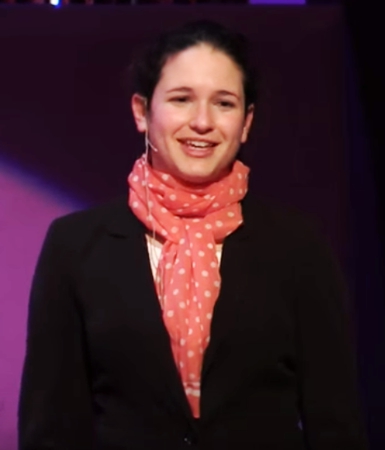
22 February 2016
Acadia participation at AGS Colloquium
Eighteen students and four professors from Acadia participated in the 42nd annual Atlantic Geoscience Society colloquium, held in Truro, NS, 5-6 February. Of the 168 participants, over 25% had connections, either as current or past students or professors. Cliff Stanley presented a fully subscribed pre-conference workshop on Quality Assurance and Quality Control in Geology Research and Exploration. Three undergraduate students presented posters on their honours thesis and project work: Roxanne LaCombe on "Metamorphic development of aluminous andalusite-staurolite schist, Pubnico Point, Nova Scotia"; David Maguire on "Petrology of metamorphic and plutonic rocks in the Neoproterozoic Chuggin Road complex, Creignish Hills, Cape Breton Island, Nova Scotia", and Max Turner (co-authored with Amanda Loder, Biology MSc student) on "Nitrogen and phosphorus availability in surface and ground water in the Cumberland Marsh Region: Impacts on productivity in constructed wetlands".
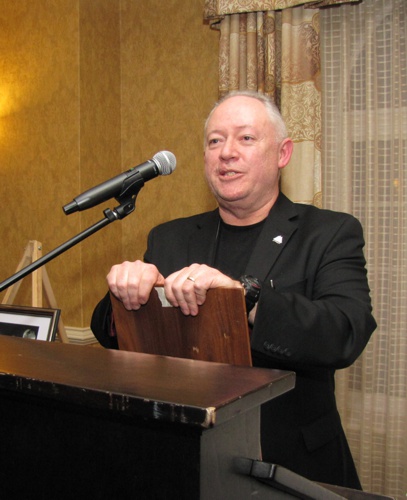
Chris White commenting after receipt of the Laing Ferguson Award for distinguished service.
At the closing banquet, awards were made to two notable members, including Dr. Chris White, who received the Laing Ferguson Award in recognition of his distinguished service to the Society. Chris is production and business manager for the society's journal, Atlantic Geology, and is an Honorary Research Associate in the department, often seen lurking in the northwest corner of the third floor (he has a desk in Sandra Barr's lab). Following the banquet, music was arranged by the Mud Creek Boys, including Ian Spooner and Peter Williams.
19 February 2016
Adam Godfrey's honours thesis published
Adam Godfrey (ENVS honours grad ‘14) and current MSc student at Acadia has had his undergraduate research work supervised by Dr. Nelson O’Driscoll and Dr. Tom Sizmur published in two prominent research journals. Adam’s research examined mercury movements in the Bay of Fundy salt marshes and mud flats.
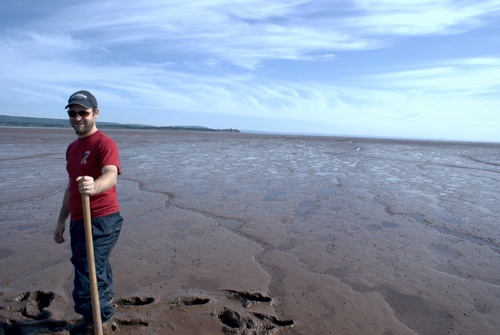
Adam assisted Dr. Sizmur with his postdoctoral research on the interactions between mercury and polycheate worms in Bay of Fundy sediments which resulted in a co-authored paper entitled “The polycheate work nereis diversicolor increases mercury lability and methylation in intertidal mudflats” in the journal Environmental Toxicology and Chemistry in 2013. The research showed that the burrow activities of the worms in sediments increased the mobility and the toxicity of mercury to the ecosystem.

Recently he was also co-author on a paper resulting from his honors work on the effects of salt march reclamation on the mercury cycle. The article “The effects of coastal managed retreat on mercury biogeochemistry” published in the journal Environmental Pollution is available for free download for a limited time here. The paper explains how the changes occurring after a coastal dyke was intentionally breached have affected the biogeochemistry of mercury in the developing salt marsh.
Having two peer reviewed journal articles from undergraduate work is exceptional and exemplifies the hands-on research education that undergraduate students are performing at Acadia.
11 January 2016
Ian Spooner and Dewey Dunnington partner with Halifax Water on NSERC ENGAGE-funded project

Dr. Ian Spooner and Dewey Dunnington (B.Sc. Acadia, 2011, M.Sc. Acadia, 2015) have partnered with Halifax Water (HW) in a $25000 ENGAGE-sponsored project that focuses on the development of accessible and rapidly employed methods of measuring the impact of watershed development and environmental change on water quality in surface water reservoirs in Halifax Regional Municipality (HRM). This project builds on a previous NSERC ENGAGE-funded project in Whistler B.C. that, in partnership with Cascade Environmental Resource Group (CERG), used lake sediment cores to understand how watershed development affects lake water quality. The Whistler Project was the basis for Dunnington’s M.Sc. research and led to the development of paleolimnological capabilities at CERG (see http://cerg.ca/now-offering-paleolimnology-services-environmental-assessment/).
The project with Halifax Water involves Dr. Graham Gagnon (NSERC Industrial Research Chair in Water Quality & Treatment at Dalhousie), Dr. Alisha Knowles (HW Water Quality Manager) and Barry Geddes (HW Watershed Manager) and is expected to be completed by May 2016.
5 January 2015

